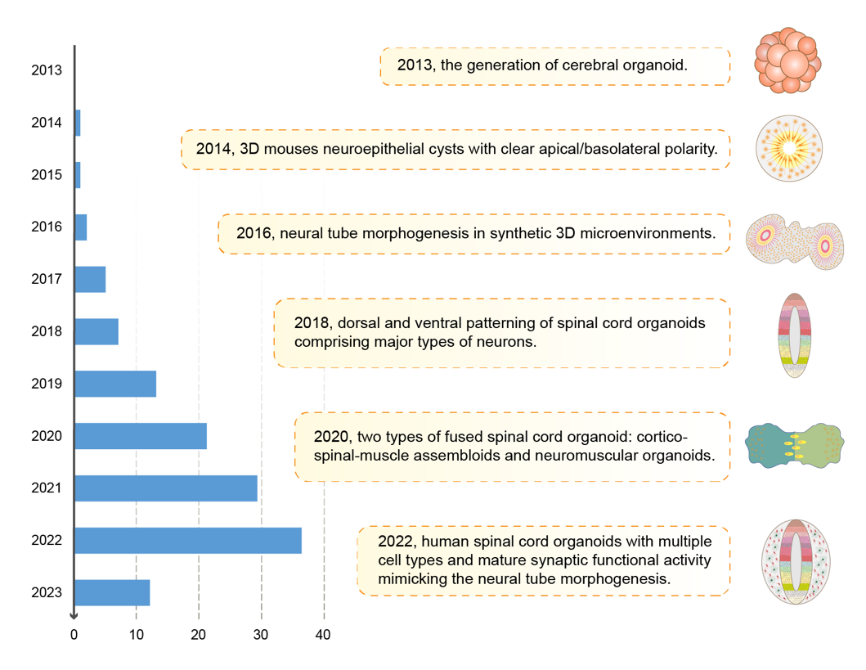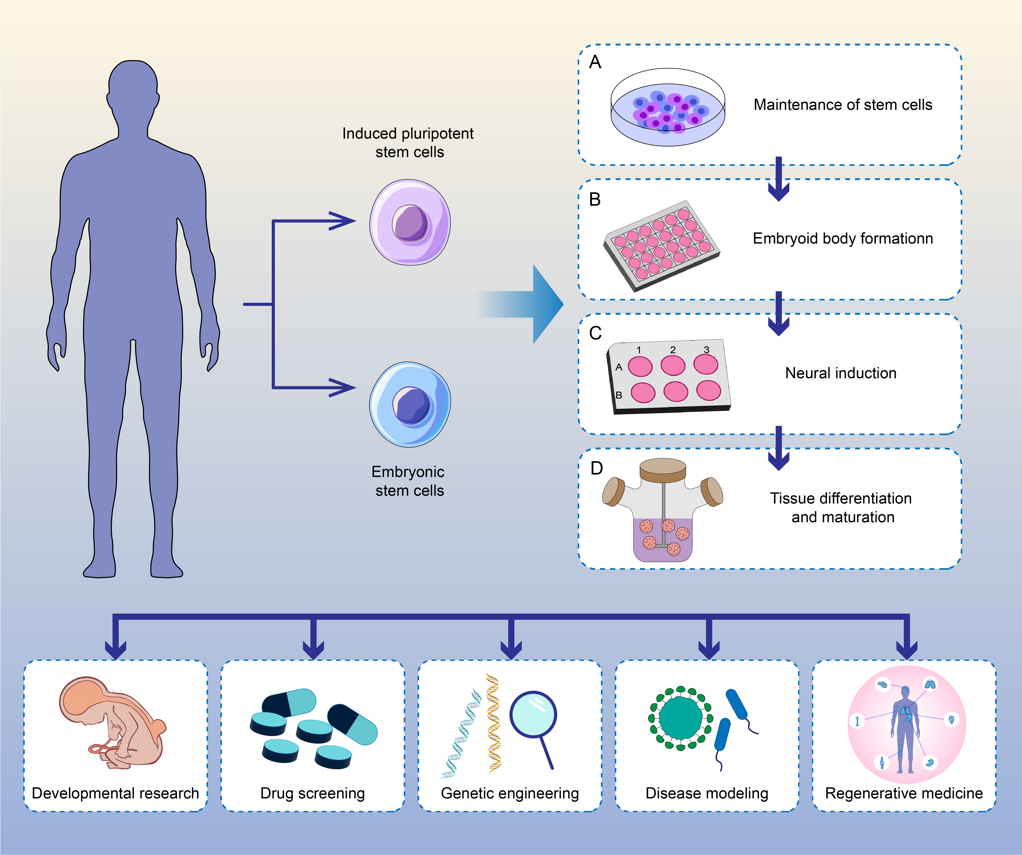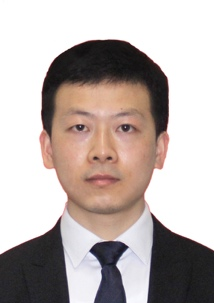NRR:中国医学科学院北京协和医院高俊团队回顾脊髓类器官的研究与进展
撰文:周刚,高俊
类器官是由干细胞在体外培养而自组织形成三维组织结构,可模拟体内特定组织器官的细胞结构和部分生理功能。自2009年荷兰科学家Sato等[1]在体外成功培养出肠道类器官以来,不同系统的三维类器官相继在体外成功培养建立。2013年,奥地利科学家Lancaster等[2]使用人诱导多能干细胞生成了第一个大脑类器官,这标志着中枢神经系统类器官的诞生。此后,研究人员不断优化培养方案,并在培养体系中加入中枢神经系统发育过程中关键尾端化信号分子,相继成功培养出后脑和脊髓类器官[3]。其中脊髓类器官不仅克服了传统二维细胞培养无法复制天然脊髓复杂表型的局限性,而且解决了人和动物模型之间种属发育差异的问题[4, 5]。因此,脊髓类器官为研究脊髓发育生物学、疾病建模、药物筛选和神经再生提供了极好的平台[5]。在过去十年间,脊髓类器官在培养体系构建、培养物的表型和功能方面均取得了重大进展。系统回顾脊髓类器官的研究进展并展望未来的发展前景,可以更好地利用脊髓类器官这一平台,推动脊髓发育、疾病发生、药物筛选、再生医学等领域的重大科研突破。
最近来自中国医学科学院北京协和医学院高俊团队在《中国神经再生研究(英文版)》(Neural Regeneration Research)上发表了题为“Progress in the generation of spinal cord organoids over the past decade and future perspectives”的综述,其通过回顾过去10年脊髓类器官在培养技术、表型以及在具体疾病中的应用,系统展示了脊髓类器官的研究进展;同时还指出了该领域目前存在的问题以及构建下一代脊髓类器官的努力方向。
高俊等首先回顾脊髓发育生物学的研究进展(图1),阐述了骨形态发生蛋白、Shh、Wnt等形态发生素在诱导脊髓模式化中的重要作用,为体外构建脊髓类器官奠定了分子生物学基础。尤其是近些年来神经中胚层祖细胞在脊髓发育中的作用被逐渐认可,传统的“激活-转化”模式收到挑战,这为后来构建神经肌肉融合类器官提供了新的思路[6]。接着,其从种子细胞、生物材料及微图案技术、生物反应器及血管化、类器官芯片、基因编辑技术几大方面,系统回顾了目前构建脊髓类器官的方法学进展。接下来展示了脊髓类器官在表型构建方面的进展。得益于方法学的巨大进步,目前脊髓类器官已经越来越接近体内脊髓组织的表型。脊髓类器官从最初仅表现为极化上皮囊腔样的结构,到同时包含腹背侧主要神经元类型的神经管类器官,再到目前包含神经元、胶质细胞和突触的复杂表型脊髓类器官,不仅具有一定的电生理功能,还可以体外复现神经管折叠的动态过程[7, 8](图2)。科学家利用脊髓类器官这一平台,在脊髓发育性疾病、脊髓退行性疾病、神经病理性疼痛、脊髓损伤等领域均取得了重大研究突破(图3)。最后综述还总结了目前脊髓类仍具有的缺陷,如较大的异质性、脊髓组织的不成熟以及不完善电生理功能[9]。下一代脊髓类器官的构建依赖于生产质量管理规范的出台,以及更加关注生物电刺激和电生理功能评估等[10]。脊髓类器官最终将为神经科学的发展带来一场科学技术革命。

图1脊髓发育过程中腹背轴、头尾轴及侧中轴示意图(图源:Zhou, et al., Neural Regen Res, 2024)

图2脊髓类器官研究的主要进展时间线(图源:Zhou, et al., Neural Regen Res, 2024)

图3脊髓类器官的简要构建步骤方案和应用(图源:Zhou, et al., Neural Regen Res, 2024)
原文链接:https://doi.org/10.4103/1673-5374.385280
参考文献
[1] Sato T, Vries RG, Snippert HJ, et al. Single Lgr5 stem cells build crypt-villus structures in vitro without a mesenchymal niche. Nature. 2009;459(7244):262-265.
[2] Lancaster MA, Renner M, Martin CA, et al. Cerebral organoids model human brain development and microcephaly. Nature. 2013;501(7467):373-379.
[3] Lippmann ES, Williams CE, Ruhl DA, et al. Deterministic HOX patterning in human pluripotent stem cell-derived neuroectoderm. Stem Cell Reports. 2015;4(4):632-644.
[4] Clevers H. Modeling development and disease with organoids. Cell. 2016;165(7):1586-1597.
[5] Li M, Izpisua Belmonte JC. Organoids - Preclinical Models of Human Disease. N Engl J Med. 2019;380(6):569-579.
[6] Henrique D, Abranches E, Verrier L, et al. Neuromesodermal progenitors and the making of the spinal cord. Development. 2015;142(17):2864-2875.
[7] Lee JH, Shin H, Shaker MR, et al. Production of human spinal-cord organoids recapitulating neural-tube morphogenesis. Nat Biomed Eng. 2022;6(4):435-448.
[8] Xu J, Fang S, Deng S, et al. Generation of neural organoids for spinal-cord regeneration via the direct reprogramming of human astrocytes. Nat Biomed Eng. 2023;7(3):253-269.
[9] Iyer NR, Ashton RS. Bioengineering the human spinal cord. Front Cell Dev Biol. 2022;10:942742.
[10] O'hara-Wright M, Mobini S, Gonzalez-Cordero A. Bioelectric potential in next-generation organoids: electrical stimulation to enhance 3d structures of the central nervous system. Front Cell Dev Biol. 2022;10:901652.

第一作者:周刚

通讯作者:高俊,教授




